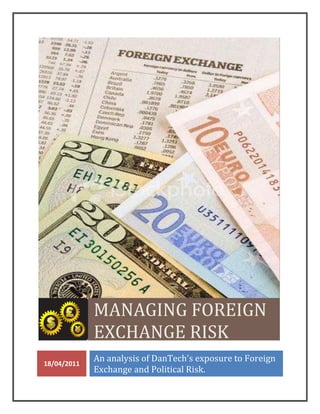DanTech is a UK-based technology company that is expanding its operations to the US through a joint venture called DanEast Ltd. DanTech will invoice US dollar exports through DanEast and import Japanese yen costs. Changes in the GBP/USD and GBP/JPY exchange rates present foreign exchange risk to DanTech's profits. The treasury manager recommends hedging techniques like money markets, forwards/futures, and options to manage this risk.
















![FIN928 Report Danial Munsoor
3259882
10 References:
CPA Australia, 2009, „A guide to managing foreign exchange risk‟, Available:
http://www.cpaaustralia.com.au/cps/rde/xbcr/cpa-
site/Guide_to_managing_foreign_exchange_risk_.pdf [Accessed 8th April, 2011]
AriclesBase, 2011, „Factors that affect foreign exchange rates‟, Available:
http://www.articlesbase.com/currency-trading-articles/factors-that-affect-foreign-exchange-
rates-4325340.html [Accessed 11th April, 2011]
Lowery, A. 2008, „This is Money‟, What makes currencies strong or weak, Available:
http://www.thisismoney.co.uk/markets/article.html?in_article_id=429456&in_page_id=3
[Accessed 13th April, 2011]
Austin, T. 2005, „Mitigating Political Risks in Large Infrastructure Projects‟, Available:
http://www.sapp.co.zw/documents/Mitigating%20political%20risks%20in%20large%20projects.
pdf [Accessed 12th April, 2011]
World Bank group, 2009, „World Investment and Political Risk‟, Available:
http://www.miga.org/documents/flagship09ebook.pdf [Accessed 16th April, 2011]
Hughes, J. & Macdonald, S. 2002, International Banking Text and Cases, Pearson Education,
Boston.
Saunders, A. and Cornett.M, 2008, „Sovereign Risk‟, Financial Institutions Management,
McGraw Hill, Singapore, pp. 437
Page 16 of 20](https://image.slidesharecdn.com/report-13206538481348-phpapp02-111107022007-phpapp02/85/Managing-Foreign-Exchange-Risk-17-320.jpg)


